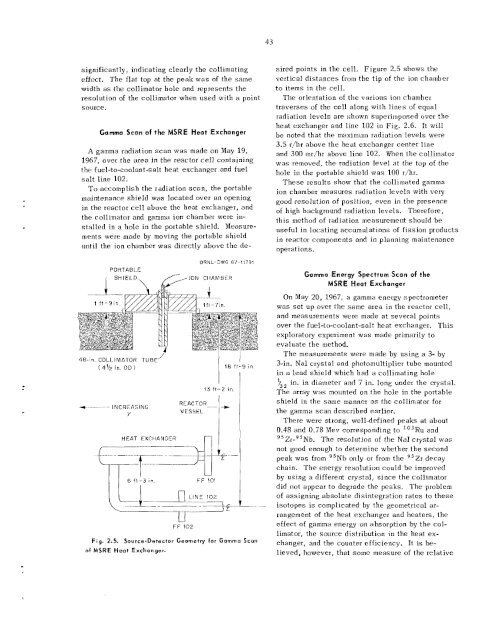ORNL-4191 - the Molten Salt Energy Technologies Web Site
ORNL-4191 - the Molten Salt Energy Technologies Web Site
ORNL-4191 - the Molten Salt Energy Technologies Web Site
You also want an ePaper? Increase the reach of your titles
YUMPU automatically turns print PDFs into web optimized ePapers that Google loves.
significantly, indicating clearly <strong>the</strong> collimating<br />
effect. The flat top at <strong>the</strong> peak was of <strong>the</strong> same<br />
width as <strong>the</strong> collimator hole and represents <strong>the</strong><br />
resolution of <strong>the</strong> collimator when used with a point<br />
source.<br />
Gamma Scan of <strong>the</strong> MSRE Heat Exchanger<br />
A gamma radiation scan was made on May 19,<br />
1967, over <strong>the</strong> area in <strong>the</strong> reactor cell containing<br />
<strong>the</strong> fuel-to-coolant-salt heat exchanger and fuel<br />
salt line 102.<br />
To accomplish <strong>the</strong> radiation scan, <strong>the</strong> portable<br />
maintenance shield was located over an opening<br />
in <strong>the</strong> reactor cell above <strong>the</strong> heat exchanger, and<br />
<strong>the</strong> collimator and gamma ion chamber were in-<br />
stalled in a hole in <strong>the</strong> portable shield. Measure-<br />
ments were made by moving <strong>the</strong> portable shield<br />
until <strong>the</strong> ion chamber was directly above <strong>the</strong> de-<br />
OR N L- 0 WG 6 7- l I791<br />
PORTAB1.E , [/ ION CIiAMBFii<br />
/<br />
48-in. COLLIMAl-OR TUBE<br />
( 4V3. in. OD)<br />
-.) ~~ --<br />
INCREASING<br />
Y<br />
HEAT EXCHANGER<br />
6 ft -3 in. FF 101<br />
FF 102<br />
I<br />
18 it-9 in<br />
I<br />
13 ft-2 in. 1<br />
Fig. 2.5. Source-Detector Geometry for Gamma Scan<br />
of MSRE Heat Exchanger.<br />
43<br />
sired points in <strong>the</strong> cell. Figure 2.5 shows <strong>the</strong><br />
vertical distances from <strong>the</strong> tip of <strong>the</strong> ion chamber<br />
to items in <strong>the</strong> cell.<br />
The orientation of <strong>the</strong> various ion chamber<br />
traverses of <strong>the</strong> cell along with lines of equal<br />
radiation levels are shown superimposed over <strong>the</strong><br />
heat exchanger and line 102 in Fig. 2.6. It wilI<br />
be noted that <strong>the</strong> maximum radiation levels were<br />
3.5 r/hr above <strong>the</strong> heat exchanger center line<br />
and 300 mr/hr above line 102. When <strong>the</strong> collimator<br />
was removed, <strong>the</strong> radiation level at <strong>the</strong> top of <strong>the</strong><br />
hole in <strong>the</strong> portable shield was 100 r/hr.<br />
These results show that <strong>the</strong> collimated gamma<br />
ion chamber measures radiation levels with very<br />
good resolution of position, even in <strong>the</strong> presence<br />
of high background radiation levels. Therefore,<br />
this method of radiation measurement should be<br />
useful in locating accumulatiot~s of fission products<br />
in reactor components and in planning maintenance<br />
operations.<br />
Gamma <strong>Energy</strong> Spectrum Scan of <strong>the</strong><br />
MSRE Heat Exchanger<br />
On May 20, 1967, a gamma energy spectrometer<br />
was set up over <strong>the</strong> same area in <strong>the</strong> reactor cell,<br />
and measurements were made at several points<br />
over <strong>the</strong> fuel-to-coolant-salt heat exchanger. This<br />
exploratory experiment was made primarily to<br />
evaluate <strong>the</strong> method.<br />
The measurements were made by using a 3- by<br />
3-in, NaI crystal and photomultiplier tube mounted<br />
in a lead shield which had a collimating hole<br />
'/32 in. in diameter and 7 in. long under <strong>the</strong> crystal.<br />
The array was mounted on <strong>the</strong> hole in <strong>the</strong> portable<br />
shield in <strong>the</strong> same manner as <strong>the</strong> collimator for<br />
<strong>the</strong> gamma scan described earlier.<br />
There were strong, well-defined peaks at about<br />
0.48 and 0.78 Mev corresponding to Io3Ru and<br />
"Zr-95Nb. The resolution of <strong>the</strong> NaI crystal was<br />
not good enough to determine whe<strong>the</strong>r <strong>the</strong> second<br />
peak was from g5Nb only or from <strong>the</strong> "Zr decay<br />
chain. The energy resolution could be improved<br />
by using a different crystal, since <strong>the</strong> collimator<br />
did not appear to degrade <strong>the</strong> peaks. The problem<br />
of assigning absolute disintegration rates to <strong>the</strong>se<br />
isotopes is complicated by <strong>the</strong> geometrical arrangement<br />
of <strong>the</strong> heat exchanger and heaters, ihe<br />
effect of gamma energy on absorption by <strong>the</strong> collimator,<br />
<strong>the</strong> source distribution in <strong>the</strong> heat exchanger,<br />
and <strong>the</strong> counter efficiency. It is believed,<br />
however, that some measure of <strong>the</strong> relative



![Review of Molten Salt Reactor Physics Calculations [Disc 2]](https://img.yumpu.com/21979492/1/190x247/review-of-molten-salt-reactor-physics-calculations-disc-2.jpg?quality=85)












